Little Rann of Kutch
On first impression, the Rann of Kutch is a vast, arid landscape, apparently devoid of all life. As far as the eye can see, the sun baked landscape stretches out without a mountain or a hill to break the monotony. Only the mirages playing on the horizon give a false impression of the presence of life saving water. But, spend some time here, and that mirage may well turn out to be thousands of flamingos feeding in a still surviving lake.
My journey began on a relatively warm winter day from Bengaluru and culminated at night in Rann Riders resort from where the foray into Little Rann of Kutch was to begin. Having met my fellow explorers at the resort, I went to sleep dreaming of the day that tomorrow was to be.
In spite of repeated warnings of cold mornings and even colder nights, the heady spirit of youth had made me neglect them and I had gone armed with only a sweater and a light jacket. But, the bone chilling wind - encountered during our first excursion into the Rann the following morning - took into account neither my sentiments nor my meagre "armaments". By the time we reached Rann and the sun was high enough to warm me up, I had wished a thousand times to be back in my cosy bed in Bengaluru.
However, when I started noticing the wildlife, returning to Bengaluru became the furthest thing in my head. From the greater short toed larks on the ground to the harriers and buzzards in the air, almost every bird was a lifer for me. The first ride into the Rann ended in high spirits having sighted a pair of Greater Hoopoe lark and the McQueen Bustard - a bustard which migrates to Kutch during winter.
The greater hoopoe lark is a ground nesting bird which nests in arid, desert and semi desert regions. Though not considered vulnerable under IUCN, it is still a rare bird and very difficult to spot and photograph. They move about either singly or in pairs scouring the ground for seeds and insects. When disturbed, they fly very low and for short distances.
The days flew by and our bird list grew - hoopoe lark, McQueen's bustard, greater short toed larks, steppe eagle, tawny eagle, kestrels, wheatears, marsh harrier, montague harrier, honey buzzard, greater and lesser flamingos, stilts ...
Finally, it was time for the last safari in Little Rann of Kutch and we decided to the end the safari by taking silhouette shots of wild ass against the setting the sun. We are all in position - the asses and the photographers - and ready to take some great shots. All of a sudden a biker materialises out of nowhere and drives the asses away, just as the sun begins to set. Not to be daunted, we quickly shift our positions and are again ready within minutes. However, a little cloud - the first and only one which we sighted in Little Rann of Kutch - decides to play spoil sport and blocks the sun. In this way, our stay in Little Rann of Kutch came to a glorious, if somewhat cloudy, end.
In the next part, I will talk about my experiences in the Great Rann of Kutch, and my dear reader if you are not already bored to death by my ramblings, please do read the second part.
Finally, I wish to thank Giri Cavale from Toehold, our drivers from Rann Riders and other members who had joined this trip for the wonderful experience.
Some information about Little Rann of Kutch :
The Little Rann of Kutch extends northeast from the Gulf of Kutch over 5,100 sq km. Once an extension of the Arabian Sea, the Rann ("salt marsh") has been closed off by centuries of silting. Even to this day, salt is being extracted from this region.
It is famous as the world's last refuge of the Indian Wild Ass (Khur) for the conservation of which it has been declared as the Indian Wild Ass Sanctuary.
 |  |  |
| Kutch Landscapes |
On first impression, the Rann of Kutch is a vast, arid landscape, apparently devoid of all life. As far as the eye can see, the sun baked landscape stretches out without a mountain or a hill to break the monotony. Only the mirages playing on the horizon give a false impression of the presence of life saving water. But, spend some time here, and that mirage may well turn out to be thousands of flamingos feeding in a still surviving lake.
 |
| The pink line on the horizon is formed by thousands of flamingos feeding in the lake |
 |
| A closer look at the pink line |
My journey began on a relatively warm winter day from Bengaluru and culminated at night in Rann Riders resort from where the foray into Little Rann of Kutch was to begin. Having met my fellow explorers at the resort, I went to sleep dreaming of the day that tomorrow was to be.
In spite of repeated warnings of cold mornings and even colder nights, the heady spirit of youth had made me neglect them and I had gone armed with only a sweater and a light jacket. But, the bone chilling wind - encountered during our first excursion into the Rann the following morning - took into account neither my sentiments nor my meagre "armaments". By the time we reached Rann and the sun was high enough to warm me up, I had wished a thousand times to be back in my cosy bed in Bengaluru.
However, when I started noticing the wildlife, returning to Bengaluru became the furthest thing in my head. From the greater short toed larks on the ground to the harriers and buzzards in the air, almost every bird was a lifer for me. The first ride into the Rann ended in high spirits having sighted a pair of Greater Hoopoe lark and the McQueen Bustard - a bustard which migrates to Kutch during winter.
 |
| Greater Hoopoe lark |
The greater hoopoe lark is a ground nesting bird which nests in arid, desert and semi desert regions. Though not considered vulnerable under IUCN, it is still a rare bird and very difficult to spot and photograph. They move about either singly or in pairs scouring the ground for seeds and insects. When disturbed, they fly very low and for short distances.
The days flew by and our bird list grew - hoopoe lark, McQueen's bustard, greater short toed larks, steppe eagle, tawny eagle, kestrels, wheatears, marsh harrier, montague harrier, honey buzzard, greater and lesser flamingos, stilts ...
 | 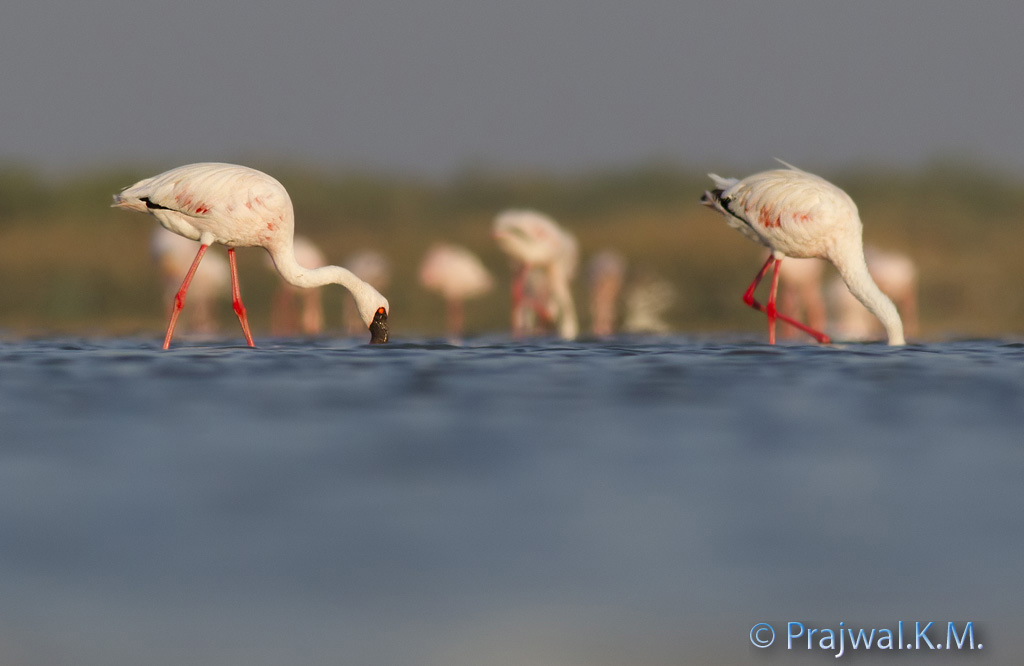 |  | 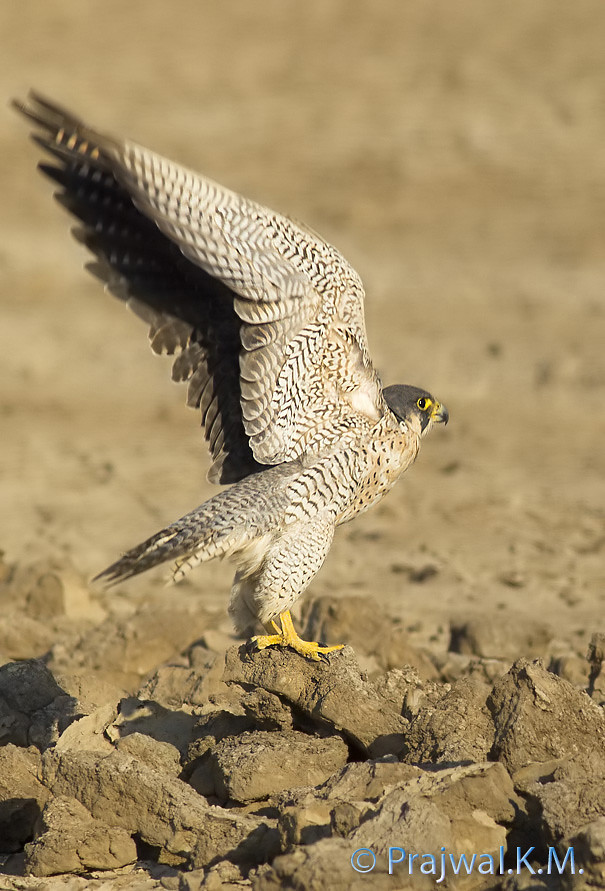 |
| Short eared owl | A group of lesser flamingos | common cranes | peregrine falcon |
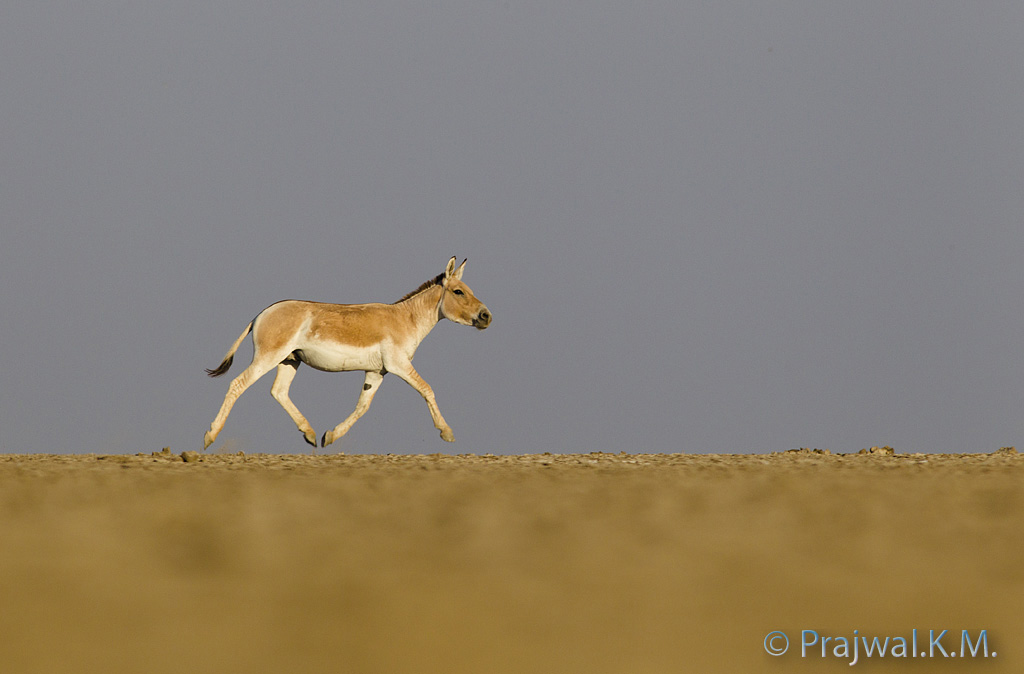 |  | 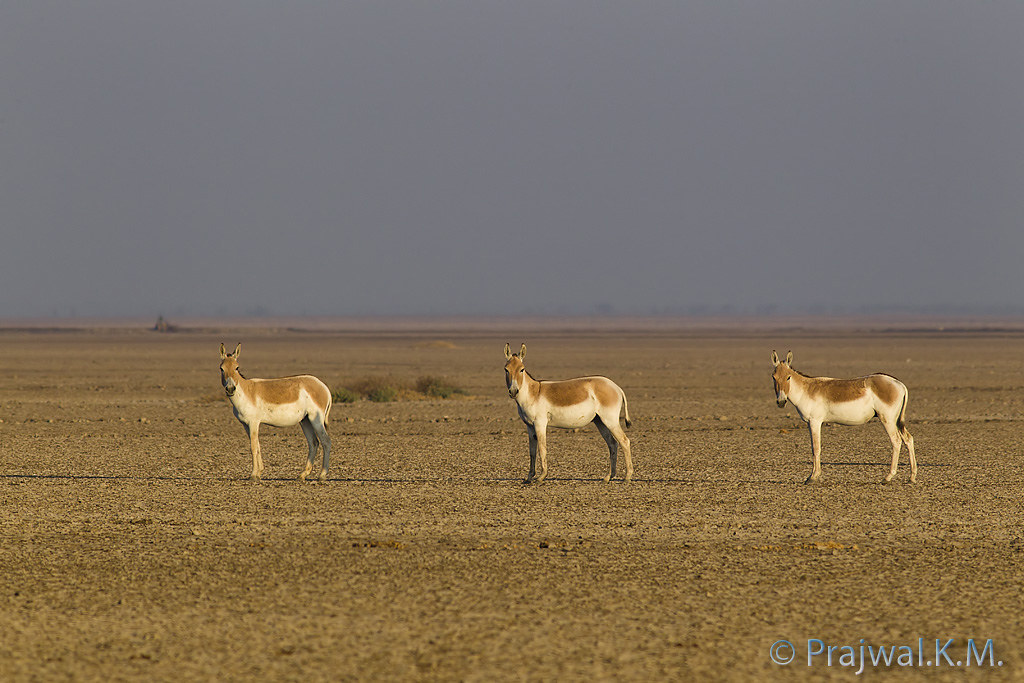 |
| Asian wild ass | Desert fox | Asian wild ass |
Finally, it was time for the last safari in Little Rann of Kutch and we decided to the end the safari by taking silhouette shots of wild ass against the setting the sun. We are all in position - the asses and the photographers - and ready to take some great shots. All of a sudden a biker materialises out of nowhere and drives the asses away, just as the sun begins to set. Not to be daunted, we quickly shift our positions and are again ready within minutes. However, a little cloud - the first and only one which we sighted in Little Rann of Kutch - decides to play spoil sport and blocks the sun. In this way, our stay in Little Rann of Kutch came to a glorious, if somewhat cloudy, end.
 | 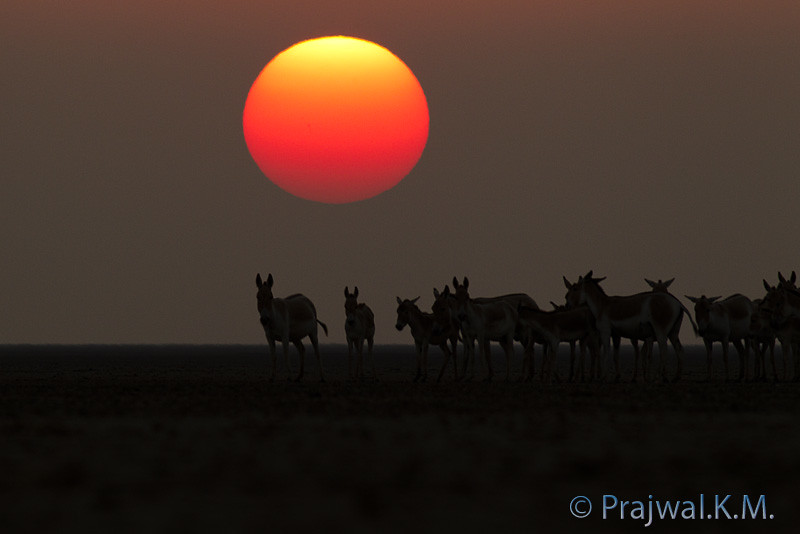 |  |
| Our last sunset at Little Rann of Kutch |
In the next part, I will talk about my experiences in the Great Rann of Kutch, and my dear reader if you are not already bored to death by my ramblings, please do read the second part.
Finally, I wish to thank Giri Cavale from Toehold, our drivers from Rann Riders and other members who had joined this trip for the wonderful experience.
Some information about Little Rann of Kutch :
The Little Rann of Kutch extends northeast from the Gulf of Kutch over 5,100 sq km. Once an extension of the Arabian Sea, the Rann ("salt marsh") has been closed off by centuries of silting. Even to this day, salt is being extracted from this region.
 |
| Salt extraction pit |
Wonderful post! Thanks for sharing!
ReplyDeleteLovely post!! :)
ReplyDeleteThanks Marianne, Angad.
ReplyDeleteNice
ReplyDeletePrajwal you got great talent bro, Im poud to have a friend like you.
ReplyDeleteThanks Nischay
ReplyDelete